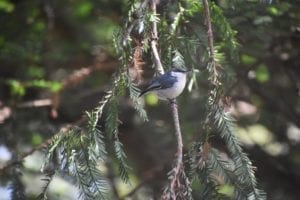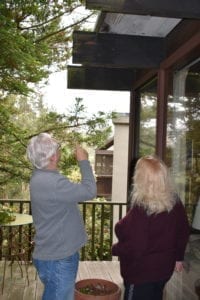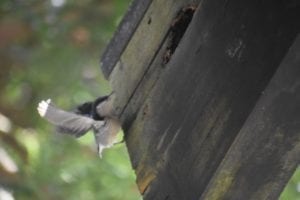
By Murray Schneider
Richard Craib raised his family on Turquoise Way, his backyard abutting the upper reaches of Glen Canyon.
Now he’s overseeing a family of white-breasted nuthatches in the house he’s lived in since 1962.
Craib sat recently in his living room, which overlooks a mini forest of pines, cypresses and redwoods. A barn owl box he’d fashioned to a backyard pine stared back at him.
It’s now empty. But a Douglas fir beam that runs along his inside ceiling and ends on the other side of his sitting room window isn’t.
As Craib watched, a nuthatch exited a cavity it had burrowed in the dark-stained beam. It moved acrobatically, twisting its head, searching for an insect or meaty seed, then flew off, alighting on a pine branch.
“There was a hole in the wood,” Craib explained, “but the nuthatch made it larger.”
While Craib studied the outside beam, a second nuthatch peeked from the hole, the size of several silver dollars and the shape of the state of Virginia. It stepped out, then decided sanctuary was more important then scenery.
Its plumage was warm and blue-gray; its under parts whitish.

Photo by Raymond McMillan
The early June day was bright and aromatic.
“This has been going on for three weeks now,” Craib said. “The hole was there a year ago, but it was smaller then.”
Nuthatches, typically four inches long and with a wingspan of nearly eight inches, range from British Columbia through the western United States and as far south as Mexico. The song bird, which averages well below an ounce, commonly nests in dead conifer stubs, lining the bottom of cavities with pine cone scales, plant duff and animal renderings.
Craib stood and walked onto his deck. Below a dog walker trailed his unleashed pet up the slope, stepping beneath Craib’s vacant owl house. Soon he and his dog were lost to view, swallowed by deciduous tree limbs and embraced by sheltering leaves.

“The birds stopped excavating and started housekeeping,” Craib said. “The female may be laying eggs.”
Females lay from four to nine eggs, depositing them in tree cavities, doing most of the incubation that lasts for approximately 16 days. Young nuthatches leave the nest about 22 days after experiencing daylight.
The species is gregarious, nesting in pairs and succor avian bunkmates.
“I think they may be building a condominium for friends,” said Craib, about birds that typically roost communally, a hundred of them capable of huddling in sequestered crevices.
Craib’s thoughts had segued to beliefs in only several months, belying any doubt that a hotel of ‘hatches had taken up residence in his Diamond Height’s hollowed out rectangle of lumber.
Click here to hear the call of the white-breasted nuthatch.
Clamorous stuttering calls of “bit, bit, bit” echoed throughout his living room.
“It’s begins about six o’clock each morning,” he said about the chorus. “and ends at dusk.”
One immediately wondered if such an early morning wake-up call might drive him nuts.
Hyperactive in its behavior, the nuthatch’s incessant and staccato vocalization is a consequence of its culinary appetite.
The bird gets its common name, according to Andy McCormick in an article titled “Pygmy Nuthatch,” from “jamming large nuts and acorns into long needled Ponderosa pine forest habitat. Wedging large nuts and acorns into tree barks, they peck and whack them with sharp bills, ‘hatching’ out the seed from the inside.”
This makes a racket, not unlike perennial City street construction jackhammers perforating roadways undergoing repairs.
Craib’s trespassing passerines yammered “Kit, kit, kit” and continued commanding his attention.
“Nuthatches are singular,” he said of his winged intruders, “in that they walk down a tree.”
With such patented gymnastics, nuthatches, whose lifespan is on average a year-and-a-half, according to the Cornell Lab of Ornithology, forage headfirst down tree trunks, searching for invertebrates and twigs to feather their arboreal dug outs.
Adults and young remain together for generations, nesting at night for warmth and protection. This cooperative behavior is rare among birds.
Nuthatch existence is threatened not just by cold and predation. The high-strung birds “are endangered in the wild by logging, forest fire and fire suppression,” writes Andy McCormick.
Living adjacent to Glen Canyon, Craib is not unfamiliar with poaching critters.
“I’ve shared my backyard with raccoons, possums and skunks,” he said. “I’ve had beehives back there, 17 mallards that would fly around and land in my kids’ wading pool, even 25 laying Leghorn chickens.”
“In 1983, I donated the last of the chickens to the junior museum after raccoons made a meal of them.”
But the former president of Friends of Glen Canyon Park and both the brains and the muscle behind the Police Academy’s Little Red Hen Community Garden has never had to don ear plugs to push back upon beam-busting squatters.
Now Craib may have to reconsider.
His nuthatches are presently sharing a daily recital of last laughs, muffled only by a length of a piece of Douglas fir that runs the width of his family room and out to a hummock of shrubs and trees.
“Ha, ha, ha!” the aerial homesteaders serenade begins each morning.
Like clockwork.